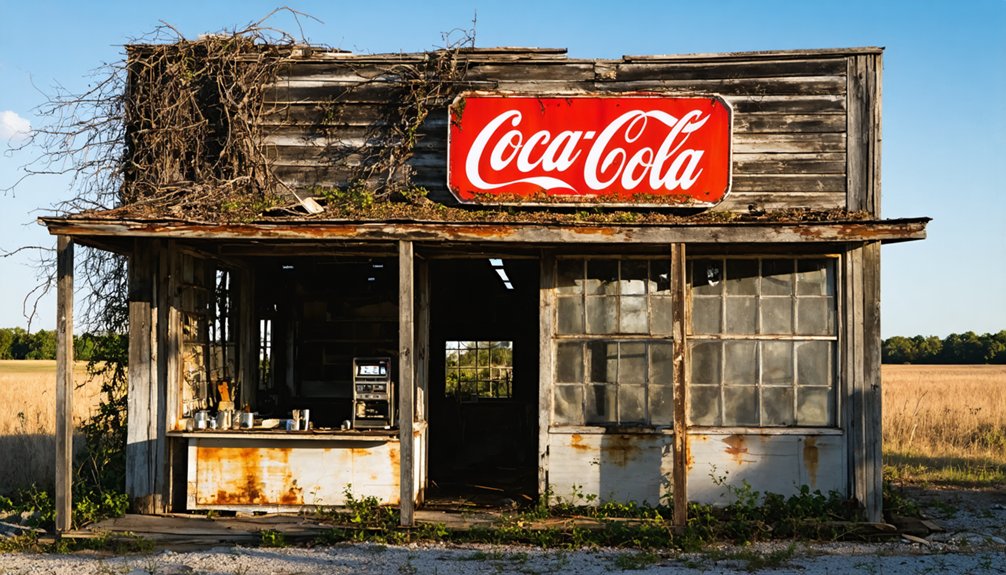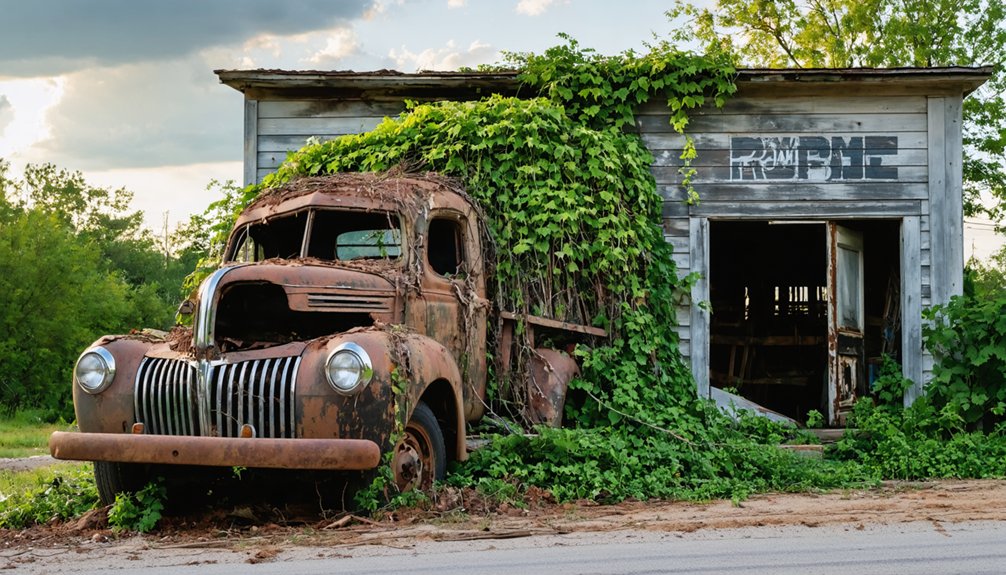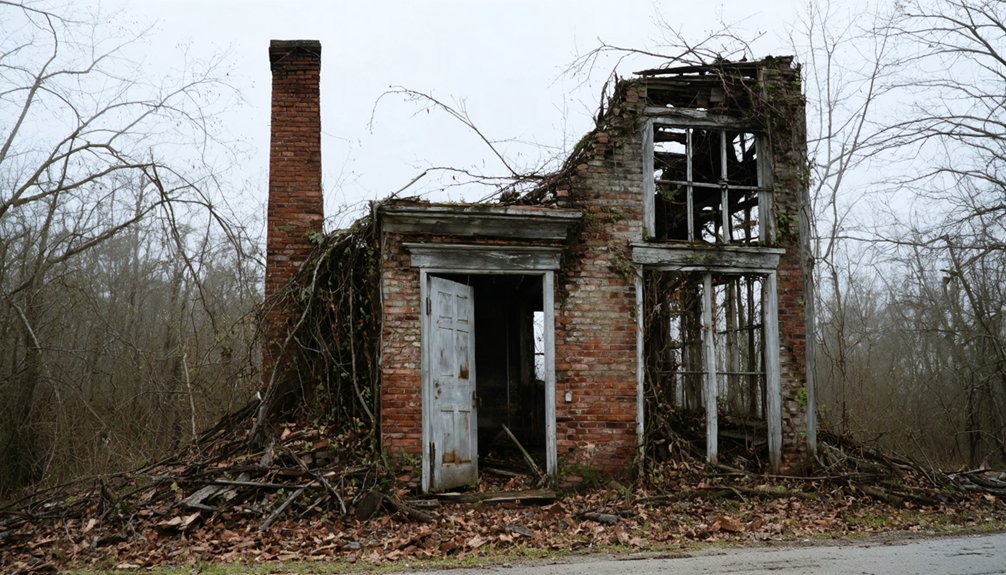You’ll find Boston, Alabama tucked away in the state’s historic Black Belt region, where it once thrived as a 19th-century agricultural settlement. The town’s rich, dark soil supported cotton farming, with tenant farming and sharecropping systems shaping its social fabric. Disease outbreaks, economic decline, and shifting transportation routes led to its abandonment. Today, deteriorating structures and scattered records tell a complex story of agricultural heritage, racial dynamics, and community resilience.
Key Takeaways
- Boston was established in 19th century Alabama’s fertile region, primarily focused on cotton farming before becoming a ghost town.
- Economic decline, shifting transportation routes, and health crises like malaria contributed to Boston’s eventual abandonment.
- The town’s infrastructure deteriorated after the Civil War, with many historic buildings left to decay over time.
- Preservation efforts face challenges due to financial constraints, weather damage, and complicated regulatory requirements for historic preservation.
- The original courthouse was repurposed as a community center for freed African Americans during Reconstruction before the town’s decline.
Origins and Early Settlement
During the 19th century, Boston emerged as a modest settlement in Alabama’s fertile region, where cotton farming dominated the local economy.
You’ll find that early settlement patterns reflected the diverse mix of Native American descendants, European immigrants, and southern migrants who sought opportunities in this promising area. Spanish explorers first traversed this land in 1540, marking the beginning of European influence in the region.
The town’s strategic location near waterways shaped its development, as you’d expect from settlements of that era. A post office, general store, and churches served as essential community hubs, while the surrounding landscape supported extensive cotton plantations.
The economic changes of early Boston centered on agricultural production and trade, with the town’s proximity to transport routes facilitating cotton shipments. Like the once-thriving port of Claiborne, Boston relied heavily on cotton production with numerous cotton gins dotting the landscape.
The community’s growth remained steady but measured, typical of rural Alabama towns establishing themselves in the 1800s.
Life in the Black Belt Region
You’ll find remnants of the Black Belt’s agricultural heritage in Boston’s farmlands, where families once tended cotton fields through tenant farming and sharecropping systems that defined daily life.
Within these rural households, extended family structures and larger household sizes reflected both economic necessity and cultural traditions rooted in the region’s African American majority population. As one of the ten counties in Alabama’s Black Belt region, Boston remained predominantly African American throughout its history.
The social fabric of Boston’s community was woven through shared agricultural work, church gatherings, and mutual support networks that helped residents navigate the persistent poverty and limited opportunities characteristic of Alabama’s Black Belt. The region’s struggles intensified when the devastating boll weevil invasion decimated cotton production in the mid-1910s.
Agricultural Legacy Lives On
While the legacy of cotton production dominates the Black Belt’s agricultural history, the region’s rich, dark soil continues to sustain a diverse farming economy today.
You’ll find modern farmers embracing sustainable practices and crop rotation, having learned hard lessons from the soil depletion that plagued earlier generations. The region’s weathered limestone base, known as Selma Chalk, provides ideal conditions for varied agriculture, from cattle ranching to aquaculture. The area’s highly fertile soil made it one of the South’s most productive agricultural regions.
Where cotton once reigned supreme, you’ll now see fields of soybeans, peanuts, and corn alongside catfish ponds and timber stands. This transformation began when cotton exports declined after dominating nearly 60% of American exports during the Civil War era.
The gentle topography and clay deposits that once attracted cotton planters now support a resilient agricultural community that’s adapted to changing times while maintaining deep connections to the land’s rich heritage.
Daily Farming Family Life
Life for Black Belt farming families revolved around the unrelenting demands of agricultural labor, with each family member playing a distinct role in the daily struggle for sustenance.
You’d find men tackling the farming challenges of plowing and planting in the resistant clay soil, while women managed domestic gardens and tended to livestock. Family roles were clearly defined, with everyone contributing to survival. Most families purchased their supplies at stores on credit from landowners, creating a perpetual cycle of debt that was nearly impossible to escape. Some Black farmers managed to break free from this cycle through black-owned banks that offered financial support for land purchases.
You’d preserve your harvest through time-tested methods – salting pork and drying vegetables to endure lean periods. If you were a sharecropper or tenant farmer, you’d live close to the fields, often trapped in a cycle of debt with local merchants.
Your days would follow the rhythm of seasons, from dawn to dusk, as you balanced cotton cultivation with growing food crops to feed your family.
Community Social Dynamics
The social fabric of Alabama’s Black Belt region reflects deep historical complexities shaped by race, economics, and power. You’ll find communities where social cohesion exists along racial lines, with persistent divisions rooted in the legacy of plantation slavery and Jim Crow segregation.
Despite these challenges, you’ll witness remarkable community resilience, particularly in areas where grassroots activism flourished during the Civil Rights Movement. As of 2000, the region’s population of 589,041 residents demonstrates the significant demographic presence within Alabama’s Black Belt. The Black Belt Region encompasses approximately 623 rural counties across multiple Southern states.
Today, you’ll observe how limited access to healthcare, underfunded schools, and deteriorating infrastructure affect daily interactions.
While some towns maintain strong African American leadership – a direct result of 1960s activism – many communities struggle with population loss as younger residents seek opportunities elsewhere.
Social services remain stretched thin, and you’ll notice how historical patterns of inequality continue to influence modern relationships between racial and economic groups.
Agricultural Legacy
You’ll find that Boston’s agricultural legacy was deeply rooted in cotton farming, which dominated the local economy during its prime years as a Black Belt settlement.
Farm families passed down their agricultural knowledge through generations, teaching techniques for soil preparation, planting timing, and harvest methods specific to the region’s rich, dark soil.
Cotton’s prominence shaped not just the economic activities but also the social rhythms of Boston’s farm families, who structured their daily lives around the crop’s demanding cultivation cycle.
Cotton Farming Dominance
During Alabama’s agricultural heyday, cotton farming dominated Boston’s economic landscape, mirroring the broader success of the Black Belt region’s rich calcareous soil.
You’d have witnessed a remarkable economic transformation as cotton production surged, making Alabama the nation’s leading producer by 1849, contributing 22.9% of U.S. cotton output.
- Local farmers capitalized on the region’s natural advantages, including fertile soil and convenient river transportation.
- Eli Whitney’s cotton gin revolutionized processing, making short-staple cotton highly profitable.
- Daniel Pratt’s local gin manufacturing accelerated the industry’s growth after 1838.
- Cotton yields brought substantial wealth, with a single 400-pound bale netting around $32.
This agricultural prosperity shaped Boston’s development, though like many farming communities, you’d later see challenges from the devastating boll weevil infestations starting in 1910.
Farm Family Traditions
Family farms across Boston’s agricultural landscape exemplified remarkable continuity, with many operations spanning more than a century on the same parcels of land.
You’ll find that these farms preserved their farming heritage through six or more generations working together, passing down invaluable knowledge of crops, soil management, and seasonal rhythms. Their family traditions encompassed not just farming practices but also the maintenance of historic farmsteads and outbuildings.
The farms sustained themselves through diverse agricultural approaches, combining cotton cultivation with food crops like corn, beans, and squash.
You’d see extended families working cooperatively, sharing equipment and labor during essential planting and harvest seasons. They’ve maintained detailed records and photographs documenting their agricultural legacy, often establishing local heritage centers to preserve their remarkable history.
Community Infrastructure
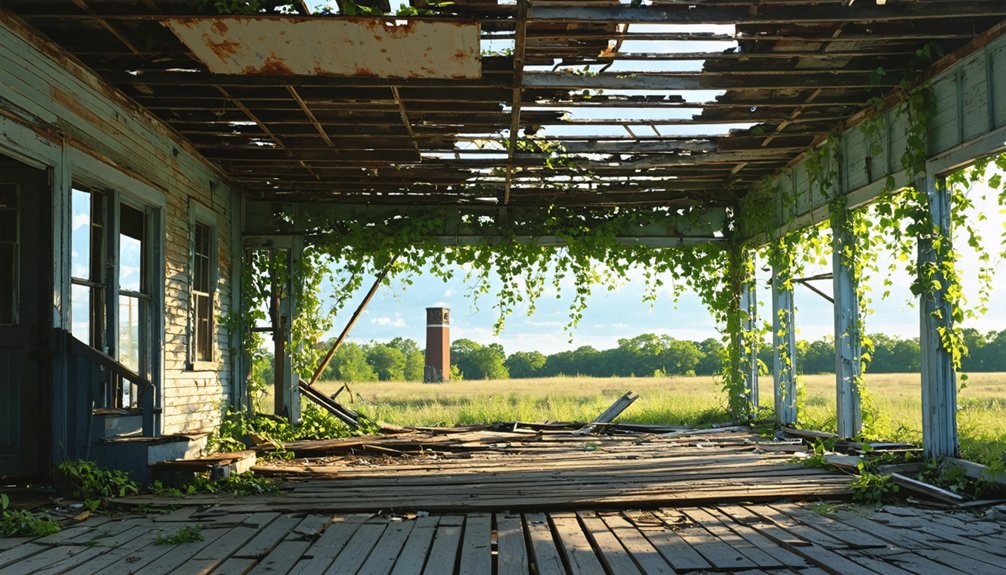
As Boston’s infrastructure developed in the mid-19th century, the town’s dependence on its railroad connection proved both beneficial and ultimately devastating.
When the Confederacy stripped the rails during the Civil War, you’ll find it marked the beginning of the town’s infrastructure decay.
Despite this setback, community resilience emerged through repurposed buildings and makeshift solutions.
- Your town’s original courthouse transformed into a crucial community center for freed African Americans during Reconstruction
- You’d discover no preserved roads or bridges remained after repeated flooding events
- The river that once fueled your commerce became a destructive force against poorly protected structures
- You’ll notice the absence of modern utilities, as the town was abandoned before widespread electrification
The Path to Abandonment
Boston’s path to abandonment began with a series of interconnected setbacks that crippled its prospects for survival.
You’ll find that the town’s decline mirrored patterns seen across Alabama’s ghost towns, where economic decline often triggered a cascade of problems. Like many settlements of its era, Boston couldn’t adapt when regional commerce patterns shifted and transportation routes evolved, causing businesses to relocate to more prosperous areas.
Health crises likely played a role in the town’s demise, as they did throughout the region.
You can trace similar patterns in places like Cahaba, where malaria and yellow fever epidemics devastated populations. When disease outbreaks coincided with economic struggles, remaining residents often chose to abandon their homes for healthier, more economically viable locations.
Physical Remnants Today
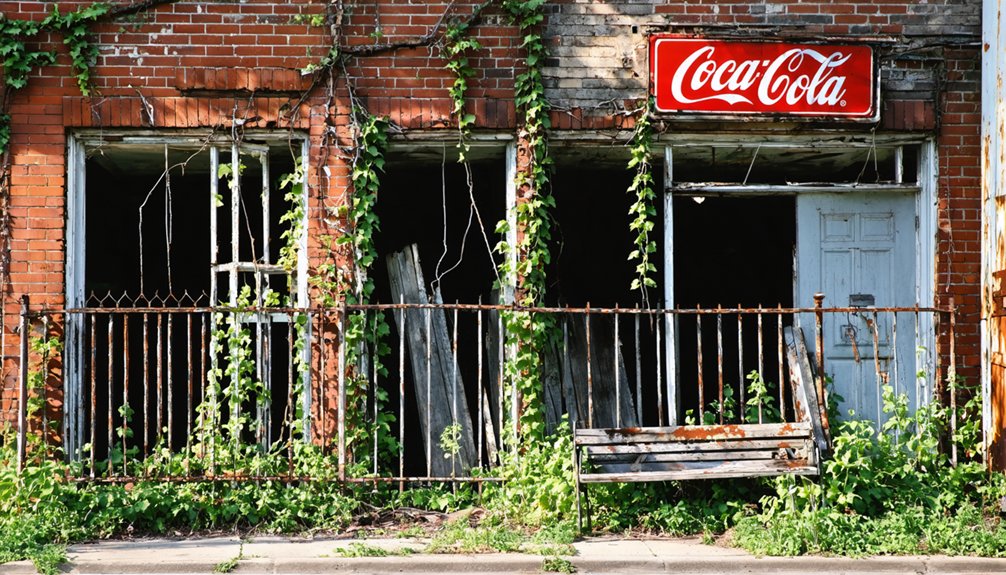
The physical remnants of Boston, Alabama offer a haunting glimpse into the town’s forgotten past. As you explore this deserted settlement, you’ll find nature steadily reclaiming what humans left behind. The abandoned structures are slowly disappearing beneath thick vegetation, while unpaved roads wind through the ghost town’s deteriorating landscape.
- Crumbling foundations and weathered walls peek through dense undergrowth, marking where homes once stood.
- Former public buildings have largely succumbed to the elements, with only scattered ruins remaining.
- Local wildlife has established new habitats among the abandoned structures.
- Natural erosion and climate conditions continue to reshape the town’s physical features.
If you’re planning to visit these remnants, be aware that the site poses safety risks due to unstable structures and overgrown terrain.
Historical Impact and Significance
While many ghost towns dot Alabama’s landscape, Boston’s historical significance stems from its origins as Cahaba, the state’s first capital established in 1819.
You’ll find layers of history here, from ancient Native American settlements to strategic governance decisions that shaped Alabama’s early statehood.
Cahaba’s significance extended beyond its role in historical governance – it was a crucial economic hub where cotton flowed through its riverports, and later, its railroad connection amplified its importance.
From bustling riverports to vital rail lines, Cahaba’s economic influence grew beyond its political roots as Alabama’s first capital.
The town’s strategic location at the confluence of two rivers made it a natural choice for administrative functions.
Though flooding ultimately led to its decline, Cahaba’s legacy lives on through its diverse historical figures, from early political leaders to freed African Americans who established communities during Reconstruction, marking pivotal shifts in Alabama’s development.
Preservation Challenges
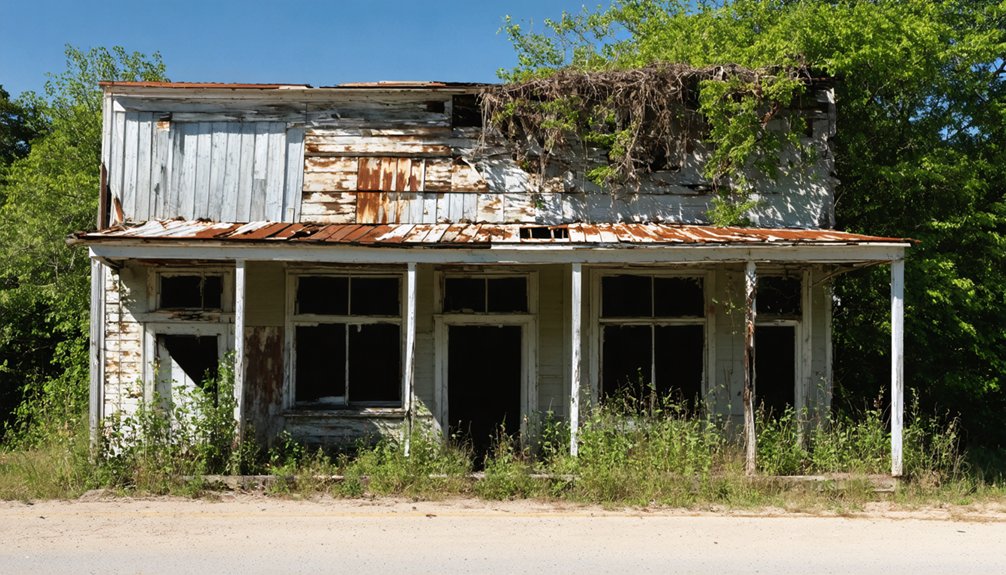
Preserving Boston’s historical legacy faces mounting challenges that span financial, environmental, and institutional domains. The limited local population makes securing preservation funding difficult, while repair costs for historic structures often exceed available resources.
You’ll find these pressing concerns affecting Boston’s survival:
- Structural deterioration accelerates due to weather exposure and flooding risks, requiring constant maintenance beyond current budgets.
- Community engagement remains vital yet challenging, as smaller towns often struggle with local apathy and preservation fatigue.
- Documentation gaps and scattered historical records complicate preservation planning efforts.
- Complex regulatory requirements and institutional coordination create barriers for accessing historic tax credits and grants.
Despite these obstacles, successful preservation depends on balancing professional expertise with authentic local voices while maintaining momentum through grassroots organizing and cultural preservation initiatives.
Research and Documentation
Historical research and documentation of Boston’s past continues through fragmented yet revealing sources that span archaeological findings, personal accounts, and institutional records.
You’ll find extensive archival resources documenting the town’s evolution from a Native American settlement to its brief role as Alabama’s capital.
Historical analysis reveals a rich tapestry of information through preserved maps, population records, and economic data.
Archaeological excavations have unearthed evidence of prehistoric occupation dating back 4,000 years, while digital archives and podcasts make this history accessible to modern researchers.
The site’s documentation benefits from ongoing photography projects using equipment like the Canon EOS M100, creating a thorough visual record.
State historical societies maintain essential records that chronicle Boston’s transformation from a thriving cotton trade center to its eventual abandonment.
Frequently Asked Questions
Were There Any Notable Crimes or Incidents in Boston’s History?
You’ll find no mysterious disappearances or historical violence in Boston itself, though nearby areas saw the dramatic arrest of Aaron Burr and a deadly 1913 tornado that devastated Dan’s community.
What Native American Tribes Originally Inhabited the Boston Area?
You’ll find the Massachusett tribe was predominant, with notable Creek relations and Cherokee influence in the broader region. The Mahican, Wampanoag, and Narragansett peoples also inhabited these lands.
Did Any Famous People or Families Come From Boston, Alabama?
You won’t find any documented famous residents or historically significant families from this location. Available records don’t indicate any notable personalities emerging from this small, abandoned settlement’s brief existence.
What Was the Peak Population of Boston During Its Most Prosperous Years?
You’re barking up the wrong tree if you’re seeking exact numbers – no verified records exist documenting population growth or economic factors during Boston’s peak years in available historical sources.
Were There Any Natural Disasters That Contributed to Boston’s Decline?
You can’t conclusively determine if natural disasters contributed to Boston’s decline, as specific historical records aren’t available. Economic decline might’ve played a role, but we lack verified evidence of environmental catastrophes.
References
- https://en.wikipedia.org/wiki/List_of_ghost_towns_in_Alabama
- https://digitalalabama.com/alabama-ghost-towns/alabama-ghost-towns/9449
- https://ahc.alabama.gov/properties/cahawba/cahawba.aspx
- https://alabamabucketlist.com/ghost-towns-in-alabama/
- https://www.tripadvisor.com/ShowUserReviews-g30754-d3405413-r702542512-Old_Cahawba_Archaeological_Park-Orrville_Alabama.html
- https://theweek.com/articles/515196/getting-flavor–alabama-ghost-town-more
- https://www.youtube.com/watch?v=NplH1TF86Ro
- https://kellykazek.com/2020/04/10/looking-for-the-history-of-this-little-ghost-town-in-north-alabama-can-you-help/
- https://encyclopediaofalabama.org/article/black-belt-region-in-alabama/
- https://cber.culverhouse.ua.edu/2019/08/07/diversity-in-alabama/
